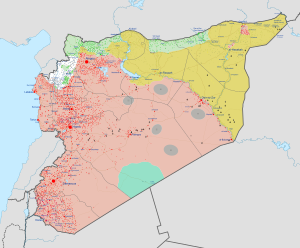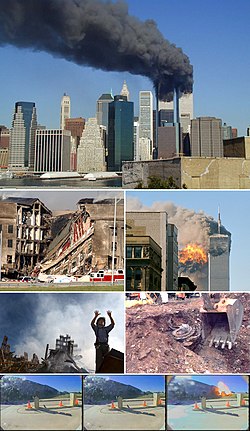 The Islamic Caliphate was established by the self-proclaimed Islamic State of Iraq and the
The Islamic Caliphate was established by the self-proclaimed Islamic State of Iraq and theLevant in regions of war torn Syria and Iraq, drawing global support from radical Sunni
Muslims. This was a modern-day attempt to re-establish Islamic self-rule in accordance
with strict adherence to Shariah- Islamic religious law. In the wake of the Syrian civil war,
Islamic extremists targeted the indigenous Arab Christian communities. In acts of genocide,
numerous ancient Christian and Yazidi communities were evicted and threatened with death by
various Muslim Shia fighter groups. After ISIS terrorist forces infiltrated and took over large
parts of northern Iraq from Syria, many ancient Christian and Yazidi enclaves were
destroyed.
The Islamic State of Iraq and the Levant (ISIL /ˈaɪsəl/), also known as the Islamic State of Iraq and Syria or Islamic State of Iraq and al-Sham (ISIS /ˈaɪsɪs/),[52] Islamic State (IS) and by its Arabic language acronym Daesh (Arabic: داعش dāʿish, IPA: [ˈdaːʕɪʃ]),[53][54] is a Salafi jihadist terrorist organisation and former unrecognised proto-state that follows a fundamentalist, Salafi/Wahhabi doctrine of Sunni Islam.[55][56] ISIL gained global prominence in early 2014 when it drove Iraqi government forces out of key cities in its Western Iraq offensive,[57] followed by its capture of Mosul[58] and the Sinjar massacre.[59]
The group has been designated a terrorist organisation by the United Nations and many individual countries. ISIL is widely known for its videos of beheadings and other types of executions[60] of both soldiers and civilians, including journalists and aid workers, and its destruction of cultural heritage sites.[61] The United Nations holds ISIL responsible for human rights abuses and war crimes. ISIL also committed ethnic cleansing on an historic scale in northern Iraq.[62]
ISIL originated as Jama'at al-Tawhid wal-Jihad in 1999, which pledged allegiance to al-Qaeda and participated in the Iraqi insurgency following the 2003 invasion of Iraq by Western forces at the behest of the United States. The group proclaimed itself a worldwide caliphate[63][64] and began referring to itself as the Islamic State (الدولة الإسلامية ad-Dawlah al-Islāmiyah) or IS[65] in June 2014. As a caliphate, it claims religious, political and military authority over all Muslims worldwide.[66] Its adoption of the name Islamic State and its idea of a caliphate have been widely criticised, with the United Nations, various governments and mainstream Muslim groups rejecting its statehood.[67]
In Syria, the group conducted ground attacks on both government forces and opposition factions and by December 2015 it held a large area in western Iraq and eastern Syria, containing an estimated 2.8 to 8 million people,[68][69] where it enforced its interpretation of sharia law. ISIL is believed to be operational in 18 countries across the world, including Afghanistan and Pakistan, with "aspiring branches" in Mali, Egypt, Somalia, Bangladesh, Indonesia and the Philippines.[70][71][72][73] In 2015, ISIL was estimated to have an annual budget of more than US$1 billion and a force of more than 30,000 fighters.[74]
In July 2017, the group lost control of its largest city, Mosul, to the Iraqi army.[75] Following this major defeat, ISIL continued to lose territory to the various states and other military forces allied against it, until it controlled no meaningful territory by November 2017.[76] U.S. military officials and simultaneous military analyses reported in December 2017 that the group retained a mere 2 percent of the territory they had previously held.[77] On 10 December 2017, Iraq's Prime Minister Haider al-Abadi said that Iraqi forces had driven the last remnants of Islamic State from the country, three years after the militant group captured about a third of Iraq's territory.[78]
----------------------------------------------------------------------------------------
Sharia, Sharia law, or Islamic law (Arabic: شريعة (IPA: [ʃaˈriːʕa])) is the religious law forming part of the Islamic tradition.[1] It is derived from the religious precepts of Islam, particularly the Quran and the Hadith. In Arabic, the term sharīʿah refers to God’s immutable divine law and is contrasted with fiqh, which refers to its human scholarly interpretations.[2][3][4] It has been described as "one of the major intellectual achievements of Islam"[5] and its importance in Islam has been compared to that of theology in Christianity.[note 1] The manner of its application in modern times has been a subject of dispute between Muslim traditionalists and reformists.[1]
Traditional theory of Islamic jurisprudence recognizes four sources of sharia: the Quran, sunnah (authentic hadith), qiyas (analogical reasoning), and ijma (juridical consensus).[8] Different legal schools—of which the most prominent are Hanafi, Maliki, Shafi'i, Hanbali and Jafari—developed methodologies for deriving sharia rulings from scriptural sources using a process known as ijtihad.[2][3] Traditional jurisprudencedistinguishes two principal branches of law, ʿibādāt (rituals) and muʿāmalāt (social relations), which together comprise a wide range of topics.[2][4] Its rulings assign actions to one of five categories: mandatory, recommended, neutral, abhorred, and prohibited.[2][3][4] Thus, some areas of sharia overlap with the Western notion of law while others correspond more broadly to living life in accordance with God’s will.[3]
Historically, sharia was interpreted by independent jurists (muftis). Their legal opinions (fatwas) were taken into account by ruler-appointed judges who presided over qāḍī's courts, and by maẓālim courts, which were controlled by the ruler's council and administered criminal law.[2][3][4] Ottoman rulers achieved additional control over the legal system by promulgating their own legal code (qanun) and turning muftis into state employees.[3] Non-Muslim (dhimmi) communities had legal autonomy, except in cases of interconfessional disputes, which fell under jurisdiction of qadi's courts.[3]
In the modern era, sharia-based criminal laws have been widely replaced by statutes inspired by European models.[3][9] Judicial procedures and legal education in the Muslim world were likewise brought in line with European practice.[3] While the constitutions of most Muslim-majority states contain references to sharia, its classical rules were largely retained only in personal status (family) laws.[3] Legislative bodies which codified these laws sought to modernize them without abandoning their foundations in traditional jurisprudence.[3][10] The Islamic revival of the late 20th century brought along calls by Islamist movements for full implementation of sharia, including reinstatement of hudud corporal punishments, such as stoning.[3][10] In some cases, this resulted in traditionalist legal reform,[note 2] while other countries witnessed juridical reinterpretation of sharia advocated by progressive reformers.[3][10][12]
The role of sharia has become a contested topic around the world. Attempts to impose it on non-Muslims have caused intercommunal violence in Nigeria[13][14] and may have contributed to the breakup of Sudan.[3]Some Muslim-minority countries in Asia (such as Israel[15]), Africa, and Europe recognize the use of sharia-based family laws for their Muslim populations.[16][17] Some jurisdictions in North America have passed bans on use of sharia, framed as restrictions on religious or foreign laws.[18] There are ongoing debates as to whether sharia is compatible with secular forms of government, human rights, freedom of thought, and women's rights.[19][20][21]





